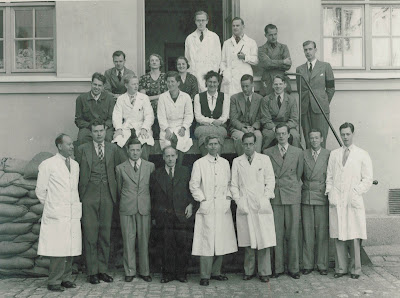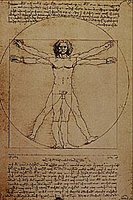
PHOTO: Elmer O. Kraemer (1898-1943), front row, third from left, and Wallace Hume Carothers (1896-1937), front row to right of Kraemer, circa the 1930's standing next to the DuPont advanced chemistry research teams they led that invented polyester and nylon. See previous posts Corporate research strategy book chronicles my grandfather's work at DuPont (5/11/15) and James Burton Nichols recalls invention of polyester and nylon at DuPont by Elmer Kraemer and Wallace Carothers (8/15/15)

PHOTO: A printed copy of the book by Thomas Kraemer's grandfather, published after he died, and the library book card that was used to check out the book from the Oregon State University library before the process was computerized decades ago. (See Google Books snippet view for Elmer Otto Kraemer, Floyd Earl Bartell, Samuel Stephens Kistler, "Advances in colloid science, Volume 1-2 and the printed copy from the Oregon State University Valley Library Storage (QD549.K68)) See previous posts Corporate research strategy book chronicles my grandfather's work at DuPont (5/11/15) and James Burton Nichols recalls invention of polyester and nylon at DuPont by Elmer Kraemer and Wallace Carothers (8/15/15)
Wow! Talk about a small world. I learned a bit about chemistry research and business growing up in the shadow of my grandfather Elmer O. Kraemer (1898-1943), who invented polyester and nylon at DuPont with his colleague Wallace Hume Carothers (1896-1937). I spent three decades of my research career at Hewlett-Packard, where I helped start HP's first research and development lab in Beijing, China and I got an education in international business as well as engineering. My past family history and work experience is probably why my attention was caught by the recent business article by Del Quentin Wilber,, "Stealing White. DuPont, China, and a billion-dollar color. How a corporate spy swiped plans for DuPont's billion-dollar color formula," Businessweek, Feb. 8-14, 2016, p. 56-61 posted online Feb, 4, 2016. Some of the key points that caught my eye were the theft of DuPont's intellectual property (e.g. patented chemicals and chemical processes to create titanium dioxide) by China via a former engineer at Hewlett-Packard who I knew. Apparently, this chemical process was originally invented when my Grandfather was leading the invention of polyester and nylon at DuPont and so I am sure he also participated in the invention process.
In addition to the above connections, by a strange coincidence, I recently learned that the gay marriage pioneer Jack Baker worked as an engineer for DuPont. (See previous post My notes on autobiography by Michael McConnell with Jack Baker gay marriage activism (2/14/16) about the book by Michael McConnell, with Jack Baker, as Told to Gail Langer Karwoski, "The Wedding Heard 'Round the World - America's First Gay Marriage," University of Minnesota Press, 2016 (Jack's DuPont job p. 33, 126 polyester and Dolese p. 9)
Here are some key quotes that caught my eye in the article by Del Quentin Wilber,, "Stealing White. DuPont, China, and a billion-dollar color. How a corporate spy swiped plans for DuPont's billion-dollar color formula," Businessweek, Feb. 8-14, 2016, p. 56-61 posted online Feb, 4, 2016:
All this whiteness is the product of a compound known as titanium dioxide, or TiO2. A naturally occurring oxide, TiO2 is generally extracted from ilmenite ore and was first used as a pigment in the 19th century. In the 1940s chemists at DuPont refined the process until they hit on what's widely considered a superior form of "titanium white," which has been used in cosmetics and plastics and to whiten the chalked lines on tennis courts. DuPont has built its titanium dioxide into a $2.6 billion business, which it spun off as part of chemicals company Chemours, in Wilmington, Del., last fall. . .
. . . as documents and testimony in a 2014 federal trial in San Francisco reveal, a naturalized American citizen, business owner, and technology consultant named Walter Liew stole DuPont's protocols for producing its superior titanium white from 1997 through 2011. He even took blueprints for a factory and used the information to win contracts worth almost $30 million. FBI agents and federal prosecutors now consider the Liew case a watershed in their understanding of Beijing's pursuit of U.S. intellectual property. Liew's defenders say the U.S. targeted a hardworking, resourceful entrepreneur to protect the bottom line of a massive U.S. corporation -- that DuPont was less victim than aggressor, recruiting law enforcement to stifle competition. . .
Of Chinese heritage, Liew was born in Malaysia in August 1957. . . Liew excelled at school and traveled overseas to earn his college degrees-a bachelor's from Taiwan University and a master's in electrical engineering in 1982 from the University of Oklahoma. He worked for Hewlett-Packard before starting a technology consulting firm in 1989, fulfilling a personal dream. "Walter's ambition really was to be more than a midlevel engineer," Stuart Gasner, his lawyer, told jurors. . .
. . . DuPont filed a lawsuit accusing Liew of stealing its trade secrets. . .
In 2014, Liew was convicted of economic espionage, possession of trade secrets, and tax fraud in federal court and has begun serving a 15-year sentence in prison. He's appealing the verdict. Gasner, who represented Liew at trial, maintains that DuPont overstated what Liew shared about its methods, saying they're "commonplace in the titanium dioxide industry."
(Quoted from Del Quentin Wilber,, "Stealing White. DuPont, China, and a billion-dollar color. How a corporate spy swiped plans for DuPont's billion-dollar color formula," Businessweek, Feb. 8-14, 2016, p. 56-61 posted online Feb, 4, 2016)
Although I don't have any direct stake in the DuPont case financially or personally, I find it interesting because the whole area of intellectual property law is one that has troubled me for decades. Clearly, I do not oppose the idea of patenting a product invention, which I learned about firsthand while helping Hewlett-Packard's patent attorneys be granted U.S. Patent number 5,883,639, which I am named as an inventor.
I fully support the original idea of granting U.S. Patents to inventors that gives them an exclusive right to sell their invention for a limited number of years before the invention becomes available in the public Doman for the good of society. A good reason for providing a limited time period is to provide inventors with an incentive to invent without having to worry about being ripped off by others, while at the same time balancing the needs of a capitalistic society for fair competition instead of allowing a monopoly forever. However, the problem I see is that companies, not individual inventors, too often use the U.S. Patent system and U.S. Copyright and Trademark protections as the way to perpetuate their profitable monopoly forever instead of these protections being something that protects an individual inventor, which was the original intention of the U.S. Patent laws. A topic for a future post.







